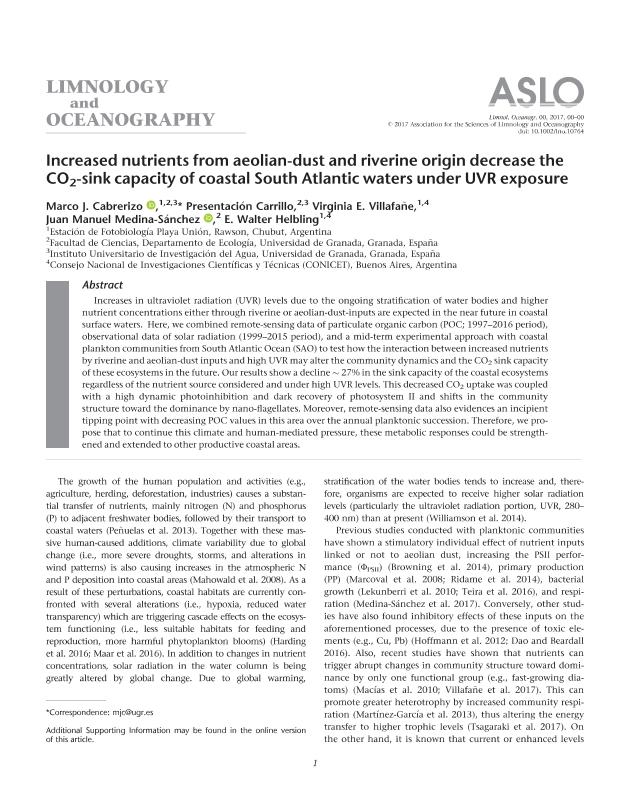Mostrar el registro sencillo del ítem
dc.contributor.author
Cabrerizo, Marco J.
dc.contributor.author
Carrillo, Presentación
dc.contributor.author
Villafañe, Virginia Estela

dc.contributor.author
Medina Sánchez, Juan Manuel
dc.contributor.author
Helbling, Eduardo Walter

dc.date.available
2022-11-08T12:34:24Z
dc.date.issued
2018-05
dc.identifier.citation
Cabrerizo, Marco J.; Carrillo, Presentación; Villafañe, Virginia Estela; Medina Sánchez, Juan Manuel; Helbling, Eduardo Walter; Increased nutrients from aeolian-dust and riverine origin decrease the CO2-sink capacity of coastal South Atlantic waters under UVR exposure; Wiley Blackwell Publishing, Inc; Limnology and Oceanography; 63; 3; 5-2018; 1191-1203
dc.identifier.issn
1939-5590
dc.identifier.uri
http://hdl.handle.net/11336/176837
dc.description.abstract
Increases in ultraviolet radiation (UVR) levels due to the ongoing stratification of water bodies and higher nutrient concentrations either through riverine or aeolian-dust-inputs are expected in the near future in coastal surface waters. Here, we combined remote-sensing data of particulate organic carbon (POC; 1997–2016 period), observational data of solar radiation (1999–2015 period), and a mid-term experimental approach with coastal plankton communities from South Atlantic Ocean (SAO) to test how the interaction between increased nutrients by riverine and aeolian-dust inputs and high UVR may alter the community dynamics and the CO2 sink capacity of these ecosystems in the future. Our results show a decline ∼ 27% in the sink capacity of the coastal ecosystems regardless of the nutrient source considered and under high UVR levels. This decreased CO2 uptake was coupled with a high dynamic photoinhibition and dark recovery of photosystem II and shifts in the community structure toward the dominance by nano-flagellates. Moreover, remote-sensing data also evidences an incipient tipping point with decreasing POC values in this area over the annual planktonic succession. Therefore, we propose that to continue this climate and human-mediated pressure, these metabolic responses could be strengthened and extended to other productive coastal areas.
dc.format
application/pdf
dc.language.iso
eng
dc.publisher
Wiley Blackwell Publishing, Inc

dc.rights
info:eu-repo/semantics/openAccess
dc.rights.uri
https://creativecommons.org/licenses/by-nc-sa/2.5/ar/
dc.subject
CO2
dc.subject
UVR
dc.subject
PHYTOPLANKTON
dc.subject.classification
Biología Marina, Limnología

dc.subject.classification
Ciencias Biológicas

dc.subject.classification
CIENCIAS NATURALES Y EXACTAS

dc.title
Increased nutrients from aeolian-dust and riverine origin decrease the CO2-sink capacity of coastal South Atlantic waters under UVR exposure
dc.type
info:eu-repo/semantics/article
dc.type
info:ar-repo/semantics/artículo
dc.type
info:eu-repo/semantics/publishedVersion
dc.date.updated
2022-11-04T11:27:35Z
dc.journal.volume
63
dc.journal.number
3
dc.journal.pagination
1191-1203
dc.journal.pais
Estados Unidos

dc.description.fil
Fil: Cabrerizo, Marco J.. Universidad de Granada; España. Fundación Playa Unión. Estación de Fotobiología Playa Unión; Argentina
dc.description.fil
Fil: Carrillo, Presentación. Universidad de Granada; España
dc.description.fil
Fil: Villafañe, Virginia Estela. Fundación Playa Unión. Estación de Fotobiología Playa Unión; Argentina. Consejo Nacional de Investigaciones Científicas y Técnicas; Argentina
dc.description.fil
Fil: Medina Sánchez, Juan Manuel. Universidad de Granada; España
dc.description.fil
Fil: Helbling, Eduardo Walter. Consejo Nacional de Investigaciones Científicas y Técnicas; Argentina. Fundación Playa Unión. Estación de Fotobiología Playa Unión; Argentina
dc.journal.title
Limnology and Oceanography
dc.relation.alternativeid
info:eu-repo/semantics/altIdentifier/url/https://aslopubs.onlinelibrary.wiley.com/doi/full/10.1002/lno.10764
dc.relation.alternativeid
info:eu-repo/semantics/altIdentifier/doi/http://dx.doi.org/10.1002/lno.10764
Archivos asociados
